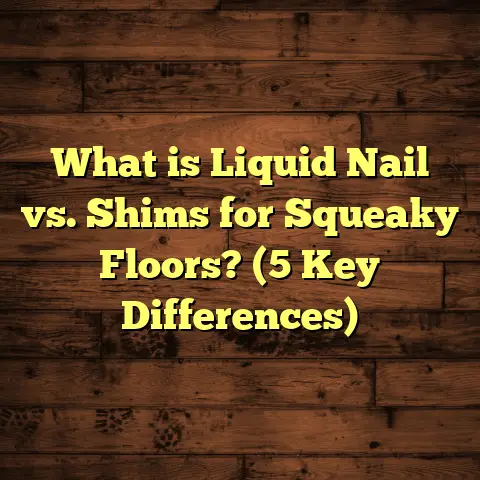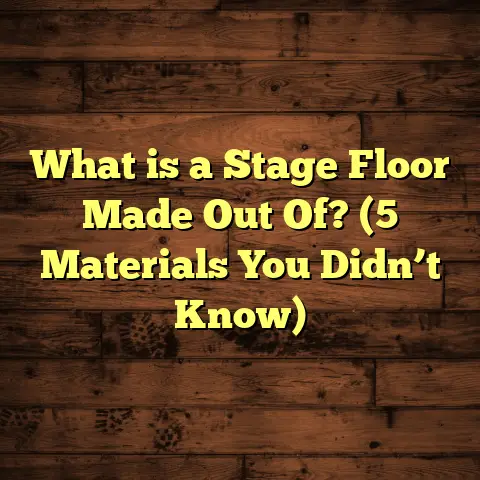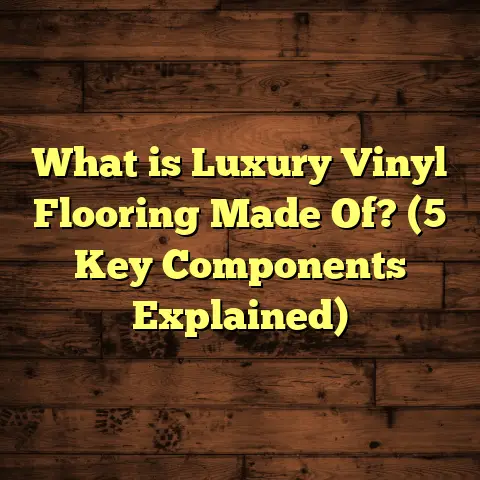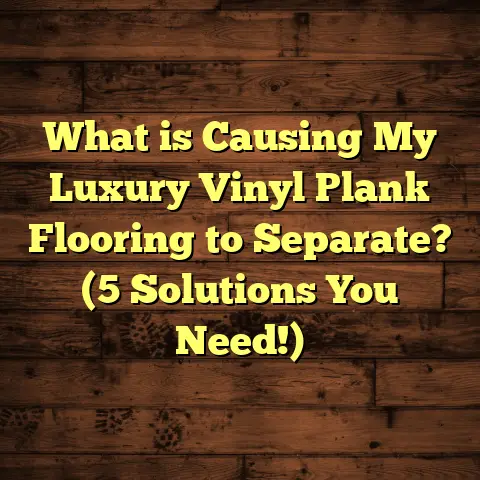What is Acid Wash Floor? (5 Benefits for Stunning Aesthetics)
I remember the first time I walked into a space with an acid wash floor—it was a small café that had just opened in my city. The moment my feet touched the floor, I was struck by how different it felt from any other concrete or tile surface I’d seen before. The floor wasn’t just a surface to walk on; it was a story told through texture, color, and subtle artistry. Over the years, I’ve worked with acid wash floors on countless projects, from residential homes to commercial spaces, and each time I’m reminded why this technique remains so popular for creating stunning aesthetics.
What Is an Acid Wash Floor?
At its core, an acid wash floor is a concrete surface treated with a mild acid solution—typically muriatic acid (hydrochloric acid)—to chemically etch the top layer of cement paste. This process exposes the aggregates (small stones, sand, or gravel) embedded within the concrete, revealing natural textures and color variations that make the floor visually rich and unique.
This isn’t just about aesthetics; it’s a chemical interaction between the acid and the calcium hydroxide in the concrete. The acid dissolves the cement paste on the surface without damaging the aggregate beneath. The result is a lightly roughened texture with areas of varying color intensity and depth.
What makes acid wash floors stand out is their unpredictability. Because every concrete slab has a different mix and aggregate composition, no two acid wash floors ever look exactly the same. This uniqueness has made acid washing a favored technique for those who want floors that tell a story.
From my experience, many people confuse acid washing with staining or polishing. Unlike stains which add color selectively or polishing which smooths surfaces to a shine, acid washing physically alters the concrete’s surface texture and coloration by selectively removing parts of it.
The Process in Detail
Here’s a quick overview of what typically happens when creating an acid wash floor:
- Preparation: The concrete surface must be clean and free of sealers or coatings that could interfere with acid penetration.
- Application of Acid Solution: A diluted acid solution is applied evenly across the floor using sprayers or mops.
- Etching: The acid reacts with the cement paste for several minutes, dissolving it to expose aggregate.
- Neutralization: After etching reaches the desired level, the floor is neutralized using a baking soda or ammonia solution to stop the chemical reaction.
- Rinsing: Thorough rinsing removes all residues.
- Drying: The floor is allowed to dry completely.
- Sealing: Finally, a sealer is applied to protect the surface and enhance its appearance.
The entire process requires care and expertise to avoid over-etching or uneven results.
Why Acid Wash Floors Are Gaining Popularity
Over the last decade, I’ve noticed an upward trend in homeowners and designers requesting acid wash floors. There’s something about their organic appeal and versatility that resonates beyond traditional flooring options.
Here are five major benefits I’ve observed firsthand that make acid wash floors so attractive.
1. Truly Unique Aesthetic Appeal
One of the most compelling reasons to choose an acid wash floor is its individuality. Unlike manufactured flooring products that come in standardized patterns or colors, acid washing creates spontaneous designs.
In one project for a client who loved rustic farmhouse style, we worked on an old concrete porch. The acid wash revealed aggregates in warm earth tones—reds, browns, and grays—that complemented the wooden trim perfectly. No two patches looked alike, giving the floor character that couldn’t be replicated with tiles or paint.
This unpredictability can be thrilling for those who appreciate natural variation and imperfections that add charm rather than detract from it.
2. Adds Texture Without Compromising Comfort
Some people worry that acid washing might leave floors feeling rough or uncomfortable underfoot. That’s rarely the case when done correctly.
The acid etches only a very thin top layer of cement paste, creating subtle texture without sharp edges or discomfort. This texture not only adds visual interest but improves slip resistance—a practical benefit in kitchens, bathrooms, and commercial spaces.
From my work in restaurants and art galleries, I’ve seen how the enhanced grip reduces slip hazards without sacrificing style.
3. Timeless Vintage Appeal
Acid wash floors evoke a sense of history and nostalgia—a look reminiscent of mid-century modern homes or aged industrial spaces repurposed into trendy lofts.
I had an opportunity to work on a warehouse conversion where we acid washed large concrete slabs. The worn-in yet sophisticated look perfectly matched exposed brick walls and steel beams. The owner wanted something authentic, not overly polished or artificial—and acid washing delivered exactly that vibe.
For those who want to create spaces that feel lived-in and inviting rather than cold or sterile, this finish resonates deeply.
4. Versatility Across Design Styles
Despite its associations with industrial and rustic aesthetics, acid wash floors can be surprisingly versatile.
By adjusting variables like acid concentration, application method, and sealing options, you can customize the look from subtle matte finishes to more pronounced textures resembling marble or granite.
I’ve used different approaches to suit modern minimalist homes as well as Mediterranean villas—all with success.
5. Budget-Friendly Compared to Alternatives
Replacing flooring can be expensive—natural stone tiles or high-end wood floors come with hefty price tags. Acid washing existing concrete slabs offers an affordable alternative that still delivers eye-catching results.
In a recent garage remodel I handled, the client wanted something more interesting than plain concrete but had a limited budget. Acid washing transformed the floor dramatically at less than half the cost of stone tiles or epoxy coatings.
Plus, since you’re working with what’s already there, labor costs drop significantly compared to full demolition and installation.
My Experience With Acid Wash Floors: Lessons Learned
Over years of working on dozens of projects featuring acid wash floors, I’ve picked up some valuable practical advice I want to share with you.
Concrete Quality Matters
Not all concrete floors respond equally well to acid washing. Floors with exposed aggregates tend to show more dramatic results because the acid exposes those natural textures beneath the surface.
Smooth finishes with minimal aggregate may result in more subtle effects—sometimes too subtle for clients expecting bold patterns.
Before committing to acid washing an entire floor, always test a small inconspicuous area first to gauge how your particular slab will react.
Be Precise With Acid Concentration
Stronger acids eat away cement paste faster but risk uneven etching or damage if misapplied.
I recommend starting with lower concentrations (around 10-15%) then adjusting based on test results. This helps prevent over-etching which can weaken your floor or produce blotchy appearances.
In one case where we used a stronger solution without proper timing control, parts of the floor became excessively rough—requiring patching later on.
Neutralize Thoroughly After Etching
Neutralization stops the chemical reaction and removes residual acids from your floor’s pores.
Using a baking soda solution mixed with water works well as a neutralizer before rinsing thoroughly with clean water.
Skipping or rushing this step can lead to discoloration or ongoing surface degradation that weakens your investment.
Sealing Is Essential
Once acid washing is complete and your floor is dry, applying an appropriate sealer protects against stains, wear, and moisture intrusion.
Sealants range from matte finishes preserving natural looks to glossy coatings enhancing color depth.
Penetrating sealers tend to last longer than film-forming ones because they soak into pores rather than just sitting on top—this also helps maintain texture without slippery buildup.
Maintenance Is Simple But Important
Regular sweeping and occasional mopping with pH-neutral cleaners keep dirt from settling into etched areas.
Avoid harsh chemicals or abrasive scrubbers which could wear away sealers prematurely.
Breaking Down Costs: Acid Wash Flooring Vs Alternatives
Cost is often a major deciding factor in selecting flooring solutions. Here’s what I’ve learned about pricing based on recent projects:
| Flooring Option | Approximate Cost per Sq Ft (Materials + Labor) | Pros | Cons |
|---|---|---|---|
| Acid Wash Concrete | $3 – $7 | Unique look; budget-friendly; durable | Requires sealing; sensitive process |
| Polished Concrete | $5 – $10 | High gloss; modern aesthetic | Higher prep costs; slippery when wet |
| Natural Stone Tiles | $10 – $25 | Luxurious appearance | High material & installation cost |
| Hardwood Flooring | $8 – $15 | Warmth and natural appeal | Prone to scratches; expensive |
| Laminate Flooring | $2 – $6 | Affordable; easy install | Less durable; artificial look |
Acid wash floors hit a sweet spot between cost-effectiveness and aesthetic impact. You get artistic character without breaking the bank.
Case Study: Transforming a Commercial Space Into a Stylish Hub
One of my favorite projects involved an urban café struggling with dull, cracked concrete floors that detracted from its hip vibe. The owners wanted something stylish but didn’t want to spend on expensive wood or tile.
We suggested an acid wash treatment combined with a matte sealer for durability and slip resistance. The transformation was dramatic: the floors now featured beautiful variegated patterns in warm gray tones complemented by exposed brick walls and industrial lighting.
Sales increased within months as customers commented frequently on how inviting and unique the space felt—a testament to how flooring impacts atmosphere.
Common Mistakes I’ve Seen With Acid Wash Floors (And How To Avoid Them)
Even though acid washing sounds simple enough, mistakes can cost you time and money:
- Skipping Test Patches: Don’t assume your concrete will react like others you’ve seen online. Always test first.
- Overusing Acid: Stronger isn’t better here—over-etching damages your slab.
- Poor Neutralization: Leaving acid residue causes discoloration later.
- Ignoring Sealing: An unsealed floor stains easily and wears faster.
- Using Wrong Sealers: Glossy sealers may create unwanted shine; choose based on desired finish.
If you’re hiring pros (which I recommend), ask about their process regarding these points before signing contracts.
Frequently Asked Questions About Acid Wash Floors
Q: How long does an acid wash floor take to complete?
A: Preparation through sealing usually takes 2-3 days depending on drying times between steps.
Q: Can acid washing be done outdoors?
A: Yes! It works great on patios and driveways but requires weather considerations during application.
Q: Will acid washing damage my concrete?
A: When done properly by professionals or careful DIYers, no significant damage occurs—just surface etching for aesthetics.
Q: What maintenance does an acid wash floor need?
A: Regular sweeping plus occasional damp mopping with mild cleaners keeps it looking fresh.
Why I Recommend Acid Wash Floors for Certain Projects
Having installed hundreds of floors over my career, I always turn to acid washing when:
- The client wants something affordable but visually striking.
- There’s an existing concrete slab in good structural shape.
- The space benefits from added texture for safety (kitchens, patios).
- The design theme calls for vintage or industrial vibes.
- Clients want low-maintenance flooring.
Final Thoughts — Bringing Character Underfoot
Floors often get overlooked when designing spaces—they’re just “something underfoot.” But floors set tone and mood profoundly.
Acid wash floors are my go-to recommendation when my clients want floors that feel alive—floors that invite touch as much as sight; floors that whisper history and natural beauty without shouting for attention.
If you’re curious about how this technique could fit your home or project, let’s chat. I’m happy to share insights tailored to your needs so you get results you’ll love stepping onto every day.
If you want me to include even deeper technical details about chemical reactions involved or specific product recommendations for sealers based on climate conditions, just let me know!





